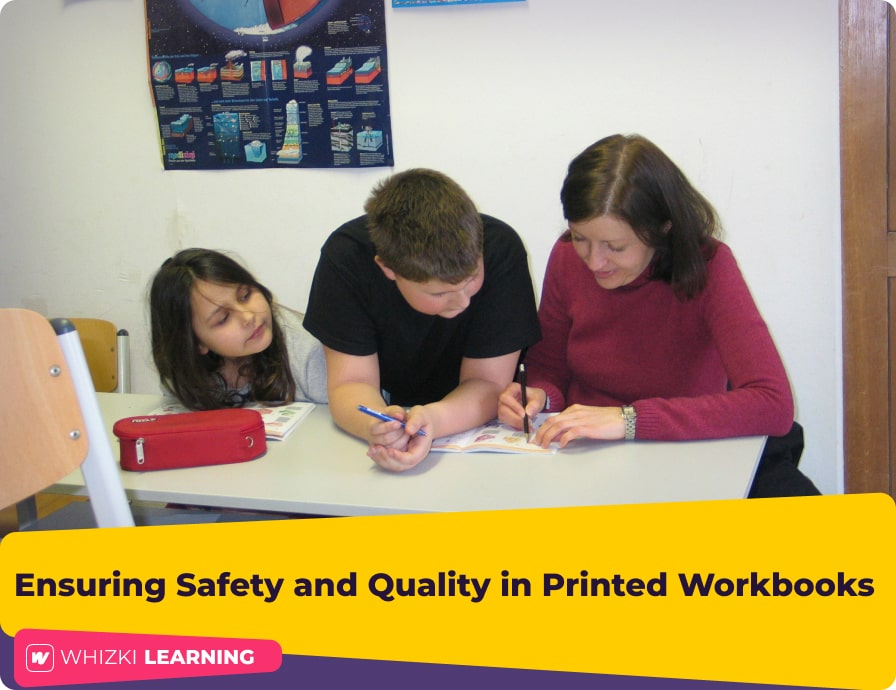Introduction: The Importance of Safety in Educational Materials
Ensuring safety in printed workbooks for young children isn’t just a matter of quality-it's about safeguarding their health and building trust with parents and educators. Children are naturally curious and tend to explore everything, including their learning materials. If these books contain harmful substances, it can lead to health issues like skin irritation or even more serious concerns over time. That’s why transparency about materials and adherence to safety standards is so essential.
Parents and teachers want assurance that every page they hand to a child is safe, non-toxic, and durable enough to withstand eager hands. A trusted workbook not only supports learning but also creates a safe environment for young learners to explore confidently.
- Choosing materials that are free from harmful chemicals like BPA, phthalates, or lead.
- Ensuring inks used are non-toxic and fade-resistant.
- Selecting sturdy, high-quality paper that resists tearing and ensures longevity.
- Looking for clear safety certifications from recognized organizations.
“As an early childhood educator, I’ve seen firsthand how important it is for our learning tools to be safe. When children hold a workbook made with non-toxic inks and durable paper, they can focus on learning without worry. Parents often tell me they feel relieved knowing that what their kids are using meets strict safety standards.” - Mrs. Sandra Klein, first grade teacher, Ohio
At the end of the day, trust in your child's educational materials comes down to transparency and quality control. When manufacturers prioritize safety in every step-from selecting eco-friendly paper to using certified inks-they create products that parents can confidently choose for their children’s growth and well-being.
Understanding the Materials: Paper Quality and Composition
When choosing printed workbooks for young learners, the type of paper used is more important than many realize. Parents and educators should look for options that are safe, eco-friendly, and gentle on little hands.
What Makes Paper Suitable for Children's Workbooks?
Non-toxic and Lead-Free: Always select paper that’s certified free from harmful chemicals like lead or heavy metals.
Inks and Printing Processes: Ensuring Non-Toxicity and Durability
When it comes to printing educational workbooks for young learners, the choice of inks and printing techniques can make a big difference in safety and durability. At Whizki Learning, we prioritize using eco-friendly, non-toxic inks that are safe for children and the environment.
Types of Safe Inks
- Soy-based inks: Derived from soybean oil, these inks are free from hazardous chemicals and produce vibrant colors without harmful fumes.
- Vegetable-based inks: Made from natural plant oils, they are biodegradable and non-toxic, making them ideal for children's educational materials.
- Water-based inks: These reduce chemical emissions during printing and are gentle on sensitive skin or accidental contact.
Printing Techniques for Durability
- UV coating: Adds a protective layer that prevents smudging and fading, extending the life of the workbook even with frequent handling.
- High-quality presses: Using advanced printing technology ensures sharp images and crisp text that won’t easily scratch or fade over time.
- Aqueous coatings: Eco-friendly finishes that provide water resistance without compromising safety or print quality.
“Parents tell me they appreciate books printed with soy-based or vegetable inks because they feel safer when their children handle them daily. Durable printing not only preserves the artwork but also supports repeated use-key in early learning environments where materials get lots of handling.” - Mrs. Sandra Klein, first grade teacher, Ohio
The Manufacturing Process: From Selection to Final Product
At Whizki Learning, we believe that safety begins right from the very first step-careful selection of materials and diligent manufacturing practices. Our goal is to produce workbooks that are not only engaging and educational but also safe for young learners.
How We Oversee Every Step of Production
- Sourcing High-Quality Materials: We partner with trusted suppliers who provide paper made from responsibly sourced fibers, free from harmful chemicals or heavy metals. Our paper is tested to meet strict safety standards before it even enters our facility.
- Selecting Non-Toxic Inks: All inks used in our printing process are vegetable-based and non-toxic, ensuring that even if children chew on pages or fingers come into contact with ink, there’s no risk of harmful exposure.
- Implementing Rigorous Quality Control: Each batch undergoes thorough inspection-checking for print clarity, color consistency, and adherence to safety certifications. Our team verifies that every workbook meets or exceeds industry standards before it reaches your hands.
- Maintaining Transparent Practices: We document each step-from material sourcing to final packaging-and share this transparency with parents and educators committed to safety.
Safety Certifications and Standards to Look For
When it comes to safety, certifications are your best friends in choosing quality printed workbooks for young learners. They offer peace of mind that the materials meet strict safety standards and are free from harmful chemicals.
- ASTM F963: This is a widely recognized safety standard for toy and educational products in the U.S., ensuring that materials used are non-toxic and safe for children.
- CPSIA Compliance: The Consumer Product Safety Improvement Act sets limits on lead, phthalates, and other hazardous substances in children’s products. Look for this label to ensure safety compliance.
- Eco-labels: Certifications like FSC (Forest Stewardship Council) or SFI (Sustainable Forestry Initiative) indicate environmentally responsible paper sourcing, which also aligns with health and safety considerations.
“Parents should always check for these certifications before purchasing workbooks. They’re more than just labels-they’re a promise that the product has been tested rigorously and meets all safety standards. A safe workbook not only protects children but also encourages their confidence and curiosity as they learn.” - Mrs. Sandra Klein, first grade teacher, Ohio
Being vigilant about these labels helps you select materials that are both safe and eco-friendly, giving children a healthy environment to explore their creativity and knowledge.
Practical Tips for Parents and Educators: Choosing Safe Workbooks
Choosing safe workbooks for young learners can feel overwhelming, but with a few simple tips, you can confidently select materials that are both engaging and secure.
Read the Labels Carefully
- Check for clear information about the paper and ink materials used.
- Look for labels indicating non-toxic, BPA-free, and environmentally friendly products.
- Pay attention to age recommendations-some safety features are specifically designed for certain age groups.
Ask Questions to Manufacturers
- Inquire about the type of inks-are they soy-based or vegetable-based?
- Request details on paper sourcing-are the papers recycled or sustainably harvested?
- Find out if the product has undergone third-party safety testing or certification.
Recognize Trustworthy Brands
- Research brands like Whizki Learning that prioritize transparency in their materials and manufacturing processes.
- Look for reviews from other parents and educators who emphasize safety and durability.
- Choose companies that openly share their standards and certifications on their websites.
Inspect Physical Products Before Use
- Check for any unusual odors-strong chemical smells may indicate unsafe inks or coatings.
- Examine the paper’s texture; it should feel smooth yet sturdy, not flimsy or rough.
- Look at the print quality-colors should be vibrant but not smudged or bleeding.
“Parents and teachers play a vital role in ensuring children’s safety by simply taking a moment to read labels, ask questions, and inspect printed materials. When we choose wisely, we’re not just protecting kids from harmful chemicals-we’re also fostering trust and confidence in their learning tools.” - Mrs. Sandra Klein, first grade teacher, Ohio
"Our Commitment at Whizki Learning": Transparency in Production & Material Choices
At Whizki Learning, transparency isn’t just a buzzword-it’s the foundation of our commitment to your child’s safety and learning experience. We believe that knowing exactly what goes into each workbook helps parents and teachers make informed choices that prioritize health and quality.
- Open communication: We share detailed information about the materials used, from paper sourcing to ink composition.
- Clear labeling: Every product includes certifications and standards met, so you can easily verify safety credentials.
- Sustainable practices: We select environmentally friendly papers and non-toxic inks to support both children’s health and the planet.
“Trust starts with transparency. Parents want to know that the workbooks their children use are safe, non-toxic, and durable. At Whizki Learning, we take pride in sharing every detail-from our paper suppliers to our printing processes-so families can feel confident about what they’re providing for their kids.” - Sarah Jenkins, Director of Product Development
This openness extends beyond words; it’s reflected in our rigorous testing and adherence to industry standards. We partner only with certified manufacturers who meet strict safety protocols, ensuring every workbook is free from harmful chemicals or contaminants. Our goal is simple: create engaging educational materials that parents can trust completely.
- Transparent sourcing: We disclose where our paper comes from, prioritizing recycled or responsibly harvested sources.
- Toxicity-free inks: All inks used are soy-based or other non-toxic options that are safe for young learners’ sensitive skin.
- Sustainable production: Our manufacturing facilities follow eco-friendly practices to minimize environmental impact.
If you’re ever unsure about a workbook’s safety, ask questions-about materials, certifications, and manufacturing processes. Knowing these details helps ensure your child’s learning environment is not only enriching but also safe and healthy.






